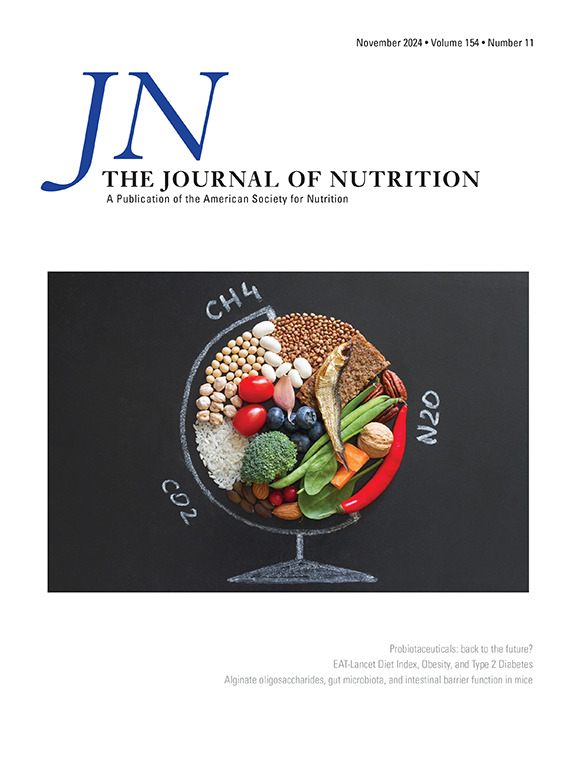Pigs Can Detect Multiple Amino Acid Deficiencies in a Choice Feeding Setting
IF 3.7
3区 医学
Q2 NUTRITION & DIETETICS
引用次数: 0
Abstract
Background
It is unknown whether pigs can detect deficiencies in multiple amino acids (AA) and consequently change their feed choice.
Objectives
We investigated whether pigs compensate for a diet deficient in three AA (Thr, Trp, and Val) by selecting multiple diets and whether this compensation is affected by the supplemented AA concentration.
Methods
Pair-housed 5-wk-old pigs (n = 96) were exposed to one of four treatments: 1) AA-adequate: offered a low-protein (LP) diet adequate in AA for growth (LP+); 2) AA-deficient: offered LP diet deficient in Thr, Trp, and Val by 20% (LP–); 3) Two-choice between LP+ and LP–; and 4) Four-choice between LP– and three diets supplemented with Thr, Trp, Val at +40% (n = 12 pens/treatment) from d0 to d21 (phase 1). From d21 to d28, AA concentration of supplemented diets increased to +60% (phase 2). Average daily feed intake (ADFI) and gain (ADG) were recorded.
Results
Dietary treatment did not affect ADFI and ADG in phase 1 (P > 0.05). In phase 2, ADFI and ADG were higher in AA-adequate and two-choice treatments than in AA-deficient treatment with four-choice in between (P < 0.05). In both phases, Thr, Trp, and Val intake was lower in AA-deficient treatment than in other treatments. For the two-choice treatment, consumption of LP– was higher than LP+ in both phases (P < 0.05 and P < 0.001). Four-choice treatment consumed more LP– and Trp-supplemented than Thr- and Val-supplemented diets in phase 1 (P < 0.001); in phase 2, consumption of the Trp-supplemented diet was the highest (P < 0.01).
Conclusions
Pigs can detect multiple AA deficiencies and compensate by consuming AA-supplemented diets. In a two-choice setting, pigs proportionally decrease consumption of a supplemented diet with increased dietary AA concentration. However, when given the choice between individual AA-supplemented diets, pigs proportionally decrease consumption of a highly concentrated Val diet and increase preference for a highly concentrated Trp diet.
在选择饲喂的情况下,猪可以检测到多种氨基酸的缺乏。
背景:猪是否能检测到多种氨基酸(AA)的缺乏并因此改变其饲料选择尚不清楚:我们研究了猪是否会通过选择多种日粮补偿三种氨基酸(Thr、Trp 和 Val)的缺乏,以及这种补偿是否会受到补充的 AA 浓度的影响:对饲养 5 周龄的猪(n= 96)进行四种处理中的一种处理:(1)AA充足:提供AA充足的低蛋白(LP)日粮以促进生长(LP+);(2)AA缺乏:提供Thr、Trp和Val缺乏20%的LP日粮(LP-);(3)在LP+和LP-之间二选一;(4)从d0-d21(第1阶段)在LP-和Thr、Trp、Val补充+40%的三种日粮之间四选一(n=12栏/处理)。从第 21 天至第 28 天,添加 AA 的日粮浓度增至 +60%(第 2 阶段)。记录平均日采食量(ADFI)和增重(ADG):结果:在第一阶段,日粮处理对ADFI和ADG没有影响(P>0.05)。在第 2 阶段,AA 充足日粮和二选一处理的 ADFI 和 ADG 均高于 AA 缺乏日粮,而四选一处理介于二者之间(两个阶段中 P- 均高于 LP+)(第 1 阶段中 P- 和 Trp 添加日粮高于 Thr- 和 Val 添加日粮)(结论:AA 充足日粮和二选一处理的 ADFI 和 ADG 均高于 AA 缺乏日粮,而四选一处理介于二者之间:猪能检测到多种 AA 的缺乏,并通过食用添加 AA 的日粮进行补偿。在二选一的情况下,随着日粮中 AA 浓度的增加,猪会按比例减少补充日粮的摄入量。然而,当猪可以在单个 AA 补充日粮之间进行选择时,猪会按比例减少对高浓度 Val 日粮的摄入,而增加对高浓度 Trp 日粮的偏好。
本文章由计算机程序翻译,如有差异,请以英文原文为准。
求助全文
约1分钟内获得全文
求助全文
来源期刊

Journal of Nutrition
医学-营养学
CiteScore
7.60
自引率
4.80%
发文量
260
审稿时长
39 days
期刊介绍:
The Journal of Nutrition (JN/J Nutr) publishes peer-reviewed original research papers covering all aspects of experimental nutrition in humans and other animal species; special articles such as reviews and biographies of prominent nutrition scientists; and issues, opinions, and commentaries on controversial issues in nutrition. Supplements are frequently published to provide extended discussion of topics of special interest.
 求助内容:
求助内容: 应助结果提醒方式:
应助结果提醒方式:


